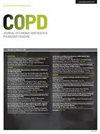Multidimensional Frailty Instruments Can Predict Acute Exacerbations Within One Year in Patients with Stable Chronic Obstructive Pulmonary Disease: A Retrospective Longitudinal Study
IF 3.1
3区 医学
Q1 Medicine
International Journal of Chronic Obstructive Pulmonary Disease
Pub Date : 2024-04-04
DOI:10.2147/copd.s448294
引用次数: 0
Abstract
Background: Chronic obstructive pulmonary disease (COPD) is closely associated with frailty, and prevention of acute exacerbations is important for disease management. Moreover, COPD patients with frailty experience a higher risk of acute exacerbations. However, the frailty instruments that can better predict acute exacerbations remain unclear.Purpose: (1) To explore the factors influencing frailty and acute exacerbations in stable COPD patients, and (2) quantify the ability of multidimensional frailty instruments to predict acute exacerbations within 1 year.
Patients and methods: In this retrospective longitudinal study, stable COPD patients were recruited from the outpatient department of Sichuan Provincial People’s Hospital from July 2022 to June 2023. COPD patients reviewed their frailty one year ago and their acute exacerbations within one year using face-to-face interviews with a self-developed frailty questionnaire. Frailty status was assessed using the Frailty Index (FI), frailty questionnaire (FRAIL), and Clinical Frailty Scale (CFS). One-way logistic regression was used to explore the factors influencing frailty and acute exacerbations. Multivariate logistic regression was used to establish a prediction model for acute exacerbations, and the accuracy of the three frailty instruments was compared by measuring the area under the receiver operating characteristic curve (AUC).
Results: A total of 120 individuals were included. Frailty incidence estimates using FI, FRAIL, and CFS were 23.3%, 11.7%, and 15.8%, respectively. The three frailty instruments showed consistency in COPD assessments (P< 0.05). After adjusting for covariates, frailty reflected by the FI and CFS score remained an independent risk factor for acute exacerbations. The CFS score was the best predictor of acute exacerbations (AUC, 0.764 (0.663– 0.866); sensitivity, 57.9%; specificity, 80.0%). Moreover, the combination of CFS plus FRAIL scores was a better predictor of acute exacerbations (AUC, 0.792 (0.693– 0.891); sensitivity, 86.3%; specificity, 60.0%).
Conclusion: Multidimensional frailty assessments could improve the identification of COPD patients at high risk of acute exacerbations and facilitate targeted interventions to reduce acute exacerbations in these patients.
多维度虚弱程度工具可预测稳定期慢性阻塞性肺病患者一年内病情急性加重:一项回顾性纵向研究
背景:慢性阻塞性肺疾病(COPD)与体弱密切相关,预防急性加重对于疾病管理非常重要。此外,体弱的慢性阻塞性肺病患者发生急性加重的风险更高。目的:(1)探讨影响慢性阻塞性肺病稳定期患者体弱和急性加重的因素;(2)量化多维体弱工具预测 1 年内急性加重的能力:在这项回顾性纵向研究中,2022 年 7 月至 2023 年 6 月期间,四川省人民医院门诊部招募了稳定期 COPD 患者。慢性阻塞性肺疾病患者使用自制的虚弱问卷进行面对面访谈,回顾一年前的虚弱情况和一年内的急性加重情况。评估虚弱状况的方法包括虚弱指数(FI)、虚弱问卷(FRAIL)和临床虚弱量表(CFS)。单向逻辑回归用于探讨影响虚弱和急性加重的因素。多变量逻辑回归用于建立急性加重的预测模型,并通过测量接收者操作特征曲线下面积(AUC)来比较三种虚弱工具的准确性:结果:共纳入了 120 人。使用 FI、FRAIL 和 CFS 估算的虚弱发生率分别为 23.3%、11.7% 和 15.8%。三种虚弱评估工具对慢性阻塞性肺病的评估结果具有一致性(P< 0.05)。在对协变量进行调整后,FI 和 CFS 评分所反映的虚弱程度仍然是急性加重的独立风险因素。CFS 评分是急性加重的最佳预测指标(AUC,0.764 (0.663- 0.866);灵敏度,57.9%;特异性,80.0%)。此外,CFS和FRAIL评分的组合能更好地预测急性加重(AUC,0.792(0.693- 0.891);灵敏度,86.3%;特异性,60.0%):多维度虚弱程度评估可提高对急性加重高风险慢性阻塞性肺病患者的识别能力,并有助于采取有针对性的干预措施,减少这些患者的急性加重。
本文章由计算机程序翻译,如有差异,请以英文原文为准。
求助全文
约1分钟内获得全文
求助全文
来源期刊

International Journal of Chronic Obstructive Pulmonary Disease
RESPIRATORY SYSTEM-
CiteScore
5.10
自引率
10.70%
发文量
372
审稿时长
16 weeks
期刊介绍:
An international, peer-reviewed journal of therapeutics and pharmacology focusing on concise rapid reporting of clinical studies and reviews in COPD. Special focus will be given to the pathophysiological processes underlying the disease, intervention programs, patient focused education, and self management protocols. This journal is directed at specialists and healthcare professionals
 求助内容:
求助内容: 应助结果提醒方式:
应助结果提醒方式:


